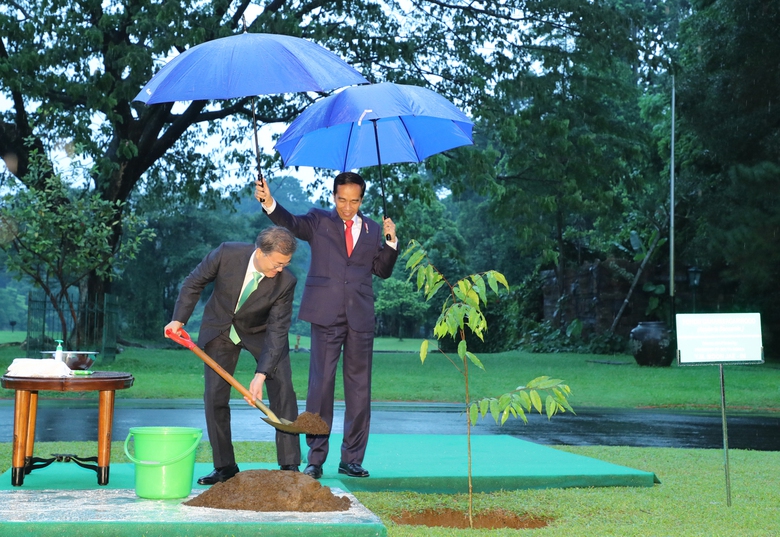 |
|
Indonesian President Joko Widodo holds an umbrella over South Korean President Moon Jae-in while he plants a Pohon Gaharu tree to commemorate his state visit to Jakarta on Nov. 9. “We will raise ASEAN-Korean relations to the same level as the four major countries (China, Russia, Japan, and the US) and pursue a new policy to dramatically improve our cooperation with ASEAN,” said Moon. (Bogor/Yonhap News)
|
Advisor says that South Korea “doesn’t need to be a part of” Free and Open Indo-Pacific policy
South Korean President Moon Jae-in’s announcement of his “New Southern Policy,” which aims to strengthen cooperative relations with the countries of ASEAN (Association of Southeast Asian Nations), during his trip to Southeast Asia has been overshadowed by a controversy over the “Indo-Pacific Strategy” that the US and Japan are promoting. “Japan is attempting to create an Indo-Pacific alignment that connects India, Australia, Japan and the US, but South Korea doesn’t need to be part of that,” said Kim Hyun-chul, one of Moon’s economic advisors who is accompanying him on the trip. Kim was in the middle of explaining ASEAN’s status as a strategic hub to reporters in Jakarta, Indonesia, on Nov. 9. The Free and Open Indo-Pacific Strategy is a policy that was first proposed by Japanese Prime Minister Shinzo Abe last year and that has received the enthusiastic support of US President Donald Trump. Stretching the original concept of the Asia-Pacific (centered on northeast Asia and southeast Asia) to include India reflects an effort to counter China’s immense influence. In a press release jointly issued shortly after Trump and Moon’s summit on Nov. 8, South Korea and the US said, “President Trump highlighted that the United States-Republic of Korea Alliance…remains a linchpin for security, stability, and prosperity in the Indo-Pacific.” But in its regular press briefing, South Korea’s Foreign Ministry responded to Kim’s remarks by saying, “There are some parts of the US’s newly elaborated strategy [the Indo-Pacific Strategy] that overlap with South Korean policy objectives,” prompting accusations that the government is contradicting itself. Another contributing factor was the fact that Kim appeared to be denying a point that had been emphasized in Moon and Trump’s summit. A senior Blue House official confirmed to reporters that Trump had in fact proposed to Moon that South Korea participate in the Indo-Pacific Strategy during their summit while adding that “This concept was left out of the joint statement to the press since President Moon was basically hearing about it for the first time. What I’m saying is that President Trump emphasized it, not that President Moon agreed to it.” The government’s position appears to reflect its emphasis on improving relations with China, which had been damaged by the deployment of the THAAD missile defense system in South Korea. This is in line with the government’s emphasis on “balanced diplomacy” and on its declaration that South Korea will not join a military alliance with the US and Japan. Moon will be holding a summit with Chinese President Xi Jinping during the APEC summit that will be held in Vietnam on Nov. 10 and 11. The Blue House responded to the growing controversy by releasing a statement late in the afternoon that said, “There are some parts of the Indo-Pacific regional doctrine recently proposed by the US that overlap with the policy of diplomatic diversification that we are pursuing. We have decided, however, that further deliberations are necessary about whether this regional doctrine is appropriate for pursuing our joint strategic goals.” The statement was an attempt to reconfirm that the government is maintaining its distance from the Indo-Pacific Strategy without rejecting it outright. By Kim Bo-hyeop and Jung In-hwan, staff reporters Please direct questions or comments to [english@hani.co.kr]






